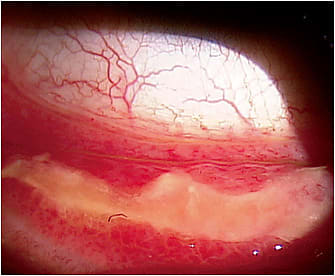
Pseudomembranous Conjunctivitis
This 59-year-old female presented to our clinic with a three-day history of ocular discomfort, swelling, redness, and discharge that first occurred in her right eye but soon involved her left eye as well. She also reported moderately reduced vision. Biomicroscopic examination revealed bilateral conjunctival injection and edema (grade 3+), lid edema, and dense pseudomembranes in the inferior fornices OD and OS. I also noted bilateral grade 2 corneal edema with subepithelial infiltrates. Her pre-auricular nodes were enlarged and very tender to palpation. Our initial diagnosis was pseudomembranous keratoconjunctivitis, likely caused by an adenovirus.
After instilling topical anesthetic drops, I used a cotton-tipped applicator to remove most of the pseudomembranes and peeled away the remaining pseudomembranes with round-tipped forceps. Given the severity of this patient’s condition, we elected to treat her condition with a 10-second 5% betadine rinse followed by irrigation with sterile saline. Over the next week, she instilled topical 1% prednisolone acetate drops q6h OD and OS and took 400mg ibuprofen gel caps q6h. Her condition resolved without sequela.
Pseudomembranes are composed of a dense, gray debris composed of dead cells, fibrin, red blood cells, white blood cells, and in some cases, organisms.1 They are commonly associated with viral keratoconjunctivitis. A recent hospital-based Australian study found that 12% of individuals who had viral conjunctivitis presented with pseudomembranes.2 Epidemic keratoconjunctivitis (EKC) is extremely common, with a prevalence of up to 70% of all conjunctivitis worldwide; EKC is commonly associated with adenovirus serotypes 8, 19, and 37.3
As the name implies, EKC is highly contagious and is unfortunately asymptomatic for up to five days prior to initial symptoms.4 Individuals who have asymptomatic EKC may touch their eyes and then touch surfaces that are later touched by another non-infected person. Adenoviral particles may remain viable on nonporous surfaces for up to one month.4 This is why consistent, persistent infection control in eyecare offices is so important.
To date, conventional antiviral agents have limited or no effect on adenoviruses that cause EKC.5 In 2005, Uchio reported excellent antiviral effects against EKC-causing viruses using zalcitabin, sanilbudine, interferon beta, and anti-osteopontin peptide.6 To date, none of those agents have received U.S. Food and Drug Administration (FDA) approval. Non-FDA-approved therapies that have been shown to shorten the duration and severity of the disease include a 5% to10% betadine rinse followed by irrigation, topical steroids, and removal of the pseudomembranes.5
As with any disease process, early definitive diagnosis is desirable. Cell cultures have been successfully used to identify viruses in keratoconjunctivitis; however, there is a time delay. In 2006, the introduction of polymerase chain reaction provided in-office testing for detecting adenovirus in tear fluid.6
When practitioners diagnose individuals with adenoviral conjunctivitis, it is essential to advise them that their condition is extremely contagious and to make every effort to educate them regarding handwashing, disinfection of any surfaces that they touch, and sharing that information with family, roommates, and anyone else who may come in contact with surfaces that they might have contacted. We also owe it to our own patients and employees to maintain a vigorous and consistent infection control plan within our own offices and clinics.
References
- Lo BM. Diphtheria Clinical Presentation. Medscape. Available at https://emedicine.medscape.com/article/782051-clinical . Accessed Aug. 2, 2019.
- Marinos E, Cabrera-Aguas M, Watson SL. Viral conjunctivitis: a retrospective study in an Australian hospital. Cont Lens Anterior Eye. 2019 Jul 9. [Epub ahead of print]
- Pihos AM. Epidemic keratoconjunctivitis: A review of current concepts in management. J Optom. 2013 Apr;6:69-74.
- Cheung D, Bremner J, Chan JT. Epidemic kerato-conjunctivitis--do outbreaks have to be epidemic? Eye (Lond). 2003 Apr;17:356-363.
- Gurwood AS. A Sticky Situation. Review of Optometry. 2017 March. Available at https://www.reviewofoptometry.com/article/ro-0317-a-sticky-situation . Accessed Aug 2, 2019.
- Uchio E. [New medical treatment for viral conjunctivitis]. Nippon Ganka Gakkai Zasshi. 2005 Dec;109:962-984.
- Sambursky R, Trattler W, Tauber S, et al. Sensitivity and specificity of the AdenoPlus test for diagnosing adenoviral conjunctivitis. JAMA Ophthalmol. 2013 Jan;131:17-22.



